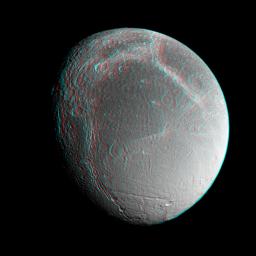Dione Anaglyph
Caption:
Saturn's moon Dione floats in the dark sky before Cassini in this anaglyph, or 3D image, taken during an encounter in late 2005. Images taken from slightly different directions allow construction of stereo views such as this, which are helpful in interpreting the complex topography of Saturn's moons.
Dione (1,126 kilometers, or 700 miles across) is covered with bright, icy cliffs revealed by Cassini.
A non-anaglyph view, taken at nearly the same time, was previously released (see
PIA07581
).
The images in this anaglyph were taken in visible light with the Cassini spacecraft narrow-angle camera on Aug. 1, 2005, at a distance of approximately 242,000 kilometers (150,000 miles) from Dione and at a sun-Dione-spacecraft, or phase, angle of about 45 degrees. Image scale is about 2 kilometers (1 mile) per pixel.
Background Info:
The Cassini-Huygens mission is a cooperative project of NASA, the European Space Agency and the Italian Space Agency. The Jet Propulsion Laboratory, a division of the California Institute of Technology in Pasadena, manages the mission for NASA's Science Mission Directorate, Washington, D.C. The Cassini orbiter and its two onboard cameras were designed, developed and assembled at JPL. The imaging operations center is based at the Space Science Institute in Boulder, Colo.
For more information about the Cassini-Huygens mission visit
http://saturn.jpl.nasa.gov/home/index.cfm
. The Cassini imaging team homepage is at
http://ciclops.org
.
Cataloging Keywords:
| Name |
Value |
Additional Values |
| Target |
Dione |
|
| System |
Saturn |
|
| Target Type |
Satellite |
|
| Mission |
Cassini-Huygens |
|
| Instrument Host |
Cassini Orbiter |
|
| Host Type |
Orbiter |
|
| Instrument |
Imaging Science Subsystem (ISS) |
|
| Detector |
Narrow Angle Camera |
|
| Extra Keywords |
Color, Visual |
| Acquisition Date |
|
| Release Date |
2006-12-29 |
| Date in Caption |
2005-08-01 |
|
| Image Credit |
NASA/JPL/Space Science Institute |
| Source |
photojournal.jpl.nasa.gov/catalog/PIA08338 |
| Identifier |
PIA08338 |

 Planetary Data System
Planetary Data System
